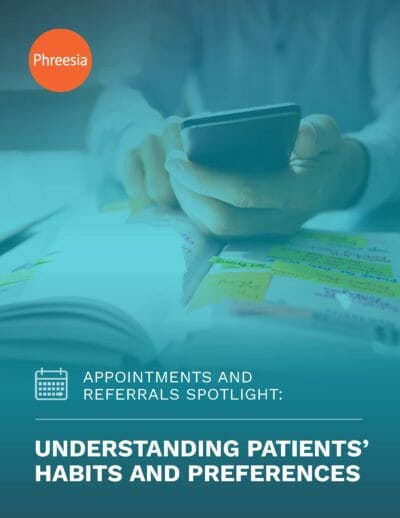As consumerism continues to reshape the healthcare landscape and patients shoulder more responsibility for their care, many provider organizations are looking for ways to align their services with patients’ values and preferences. But without good data about what patients prefer—and what their current habits are—making changes often involves little more than guesswork.
That’s certainly true of the appointments and referrals processes. To help address that gap and give healthcare organizations the information they need to evaluate their own processes and identify potential areas for improvement, Phreesia surveyed nearly 14,000 patients from across its network.
Read this white paper for valuable insights about patients’ preferences and habits related to appointments and referrals.
Click the image to open the white paper
Appointments and Referrals Spotlight: Understanding Patients’ Habits and Preferences
Patients want flexibility and convenience
- Ages 25-34 prefer to schedule appointments online
- 25% of patients prefer text message appointment reminders
- 48% of patients aged 65+ say they 77% always follow through on referrals
How Do Patients Like to Schedule Appointments?
Appointment scheduling is one of the most central processes in a medical practice. If patients have trouble making appointments, they won’t be able to access care and the organization will be unable grow and achieve its mission. Scheduling an appointment used to mean just one thing: picking up the phone and calling the practice.
But a growing number of patients are choosing to schedule their medical appointments online, at times of the day that work best for them.
According to Phreesia’s survey of nearly 14,000 patients, 18% of respondents said they preferred to schedule appointments with their healthcare provider online, while 65% said they preferred scheduling over the phone and 15% preferred scheduling in-person.
The percentage of patients who preferred online appointment scheduling was higher among younger patient groups—21% among respondents ages 18 to 24, 25% among those 25 to 34, and 24% among those 35 to 44. The numbers among older patients are slightly lower—14% for patients 55 and 64, and 8% among those 65 and older—but that doesn’t mean older adults won’t use online appointment scheduling.
In an article from consulting firm McKinsey & Company, the authors called the notion that only young people use technology to manage their health and healthcare needs “one of the most common myths about healthcare consumerism.”1 While millennials were most likely to schedule an appointment online, check their health information or text with their provider, a significant and growing number of adults over age 65 enthusiastically embrace technology when given the opportunity.
Why do many patients prefer scheduling appointments online? The process is often faster and it can be done during or outside of normal business hours, on a computer or mobile device. In fact, online appointments is among the consumer- centric features patients are increasingly seeking out when choosing a practice.
According to recent research from the consulting firm Accenture, the majority of patients think it’s important to have the ability to book, change or cancel appointments online2.
When the patients across Phreesia’s network were asked how long they typically had to wait when scheduling a medical appointment over the phone, 16% said they were on hold between 2 and 5 minutes, and 7% said they typically waited on hold for more than five minutes. In other words, nearly a quarter of patients reported that their typical hold time was over two minutes.
That’s a concerning data point considering long hold times (and possible hang-ups) not only negatively impact the patient experience, but they can also impact revenue, patient retention, online reviews and word-of-mouth referrals.
KEY TAKEAWAY: Patients increasingly prefer the option to schedule their medical appointments online. Healthcare organizations should consider offering that feature as a way to improve the patient experience and drive retention—but also as a means to improve efficiency and reduce staff workload.
Understanding Referrals Follow-Through
Referring patients to other providers for tests, consultations or additional treatments is one of the most common processes in healthcare. Referrals are an important way to ensure patients get appropriate, coordinated care, and they’re also a key source of new patients and practice revenue for specialists. Referrals are made in nearly 1 in 10 ambulatory appointments in the U.S., resulting in 100 million referrals each year3.
Yet as providers know all too well, handing a patient a slip of paper does not necessarily mean that a visit will occur. According to a joint report released earlier this year by the Institute for Healthcare Improvement and the National Patient Safety Foundation, up to 50% of referrals aren’t completed— breakdowns they say can lead to missed or delayed diagnoses and delayed treatment4.
The referrals process is often characterized by multiple calls, long lead times and confusion for patients, and by time- consuming manual tasks and fragmented communication for providers.
According to Phreesia’s survey of nearly 14,000 patients, 41% said they had received a referral during the past year. Those percentages were higher among older patients, not surprisingly given their higher rates of chronic diseases and higher usage of healthcare services. Among patients ages 18 to 24, only 31% had received a referral in the past year. That percentage jumped to 43% among respondents ages 45 to 54 and to 46% among patients aged 65 and older.
When patients were asked how often they followed through on referrals, 69% said “always,” 18% said “very often,” 9% said “sometimes,” 2.2% said “rarely” and 3% said “never.” But once again, responses depended heavily on patients’ age. Among the youngest patients, ages 18 to 25, the rates for “sometimes” “rarely” and “never” following through on referrals jumped to 15%, 8% and 5%, respectively. Patients 65 and older reported always following through on referrals 77% of the time, with only 1% saying they never follow through.
Healthcare organizations need to take these generational differences into account when devising strategies to engage patients and improve their experience—while still avoiding the myth that older adults are resistant to use technology5.
Perhaps the most challenging black box related the referrals process is why so many patients don’t follow through on their visits. When surveyed patients were asked that exact question, they cited a mix of factors.
Twenty-two percent said they felt better, 14% said they forgot, 14% said they went to a different healthcare provider, 13% said the cost was too high, and 6% said they were confused about what to do.
Once again, age matters. Nearly a quarter of respondents ages 18 to 24 said the primary reason they don’t follow through on referrals is because they forgot, while only 7% of those 65 and older gave that reason. Interestingly, 22% of those over 65 cited going to a different provider as the primary reason why they did not follow through, the highest rate of any age group. Cost concerns also seemed to rise with age, with 15% of adults ages 55 to 64 listing it as their primary reason for not following through. That percentage drops to 6% among respondents over 65, perhaps because those patients have reached the eligibility age for Medicare.
KEY TAKEAWAYS: Whether a patient receives referrals, whether they follow through on them, and the reasons why they don’t follow through are highly dependent on age. Practices’ efforts to streamline the referrals process and make it more convenient should take into account those generational differences. In addition, clear communication with patients, price transparency, reminders and other improvements can help to address the specific reasons why patients say they don’t follow through.
Appointment Confirmations: Which Methods Do Patients Prefer?
There are a range of ways to remind patients about an upcoming appointment, such as a postcard sent through the mail or a phone call. Research has shown that patients like using technology-enabled tools for these types of processes. In a 2017 McKinsey & Company survey, the majority of respondents said they wanted digital solutions at each step of the healthcare journey6. Still, some practices worry that their patients—in particular, their older patients—will be slow to adopt new technology.
According to Phreesia’s survey results, those concerns are unfounded. When asked how they would like to be reminded about upcoming appointments, 48% of respondents said they prefer text message. That’s compared with 29% who said they prefer a phone call and 21% who prefer an email reminder.
The percentage of patients who preferred text message reminders hovered close to the 50% mark across age groups—51% among respondents ages 18 to 24, 52% among those ages 25 to 34, 54% among those 35 to 44, 54% among those ages 45 to 54, and 47% among respondents ages 55 to 64.
Thirty-four percent of patients age 65 and older, or more than one in three, said they prefer text message appointment reminders, an especially important data point since these older patients are often assumed to be less likely to embrace technology despite plenty of evidence to the contrary.
Interestingly, 51% of women surveyed said they prefer to be reminded about an upcoming appointment via text message, while 42% of men said they prefer text message reminders. Those preferences are especially important since, according to the U.S. Department of Labor, women often serve as the primary healthcare decision-maker in households, making 80% of healthcare decisions.
When patients who took the survey were asked what method they preferred to use to cancel or reschedule an appointment, nearly a quarter of patients said a text message, while 64% said they preferred a phone call. Just as with appointment reminders, patients under 65 were more likely to choose text message, but those preferences are clearly evolving. Among patients 65 and older, 12% said they preferred to schedule or cancel and appointment via text, but that percentage jumped to 21% among respondents ages 55 to 64, 29% among those 45 to 54, and 32% among respondents ages 35 to 44.
Those data points align with past research that shows patients like using text messages to communicate and that texting is an effective way to engage them in their care7.
KEY TAKEAWAYS: Patients’ growing preference for text messaging means that healthcare organizations should leverage that enthusiasm to improve communication and drive engagement. Offering text message appointment reminders and allowing patients to confirm, cancel or reschedule via text can streamline processes, reduce staff workload and decrease the likelihood of no-shows while giving patients the experience they want.
1. “Debunking common myths about healthcare consumerism,” McKinsey & Company, December 2015. https://www.mckinsey.com/industries/healthcare-systems-and-services/our-insights/debunking-common- myths-about-healthcare-consumerism#0
2. “Patient Engagement: Digital self-scheduling set to explode in healthcare over the next five years,” Accenture, 2016.
3. “Selecting a Specialist: Adding Evidence to the Clinical Practice of Making Referrals,” JAMA, Nov. 12, 2014. https://jamanetwork.com/journals/jama/article-abstract/1930825?redirect=true
4. “Closing the Loop: A Guide to Safer Ambulatory Referrals in the EHR Era,” Institute for Healthcare Improvement / National Patient Safety Foundation, 2017.
5. “Assessing the Generational Differences in Patient Engagement,” Patient Engagement HIT, Dec. 19, 2017.
6. “Enabling healthcare consumerism,” McKinsey & Company, May 2017. https://healthcare.mckinsey.com/enabling-healthcare-consumerism
7. “Direct-to-patient email and text communication is best for engaging patients in their care,” MedCity News, Feb. 5, 2017. https://medcitynews.com/2017/02/direct-patient-email-text-communication-best-engaging-patients-care/






